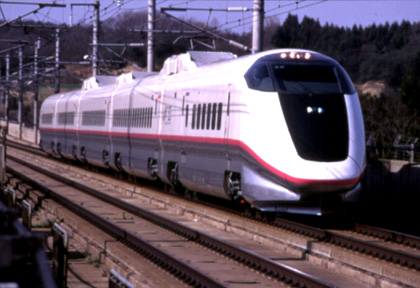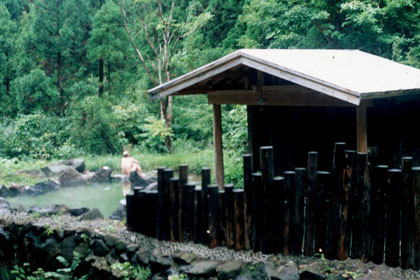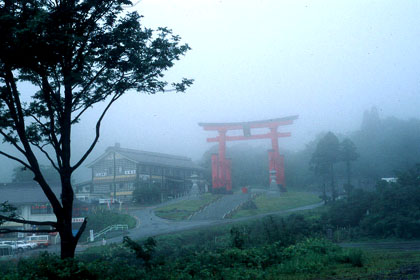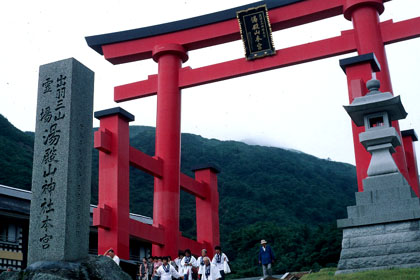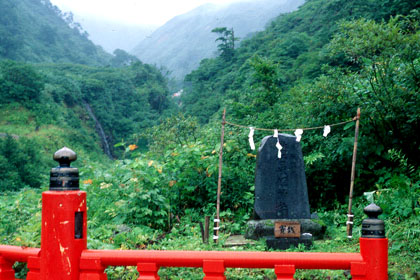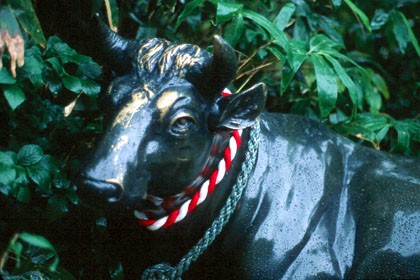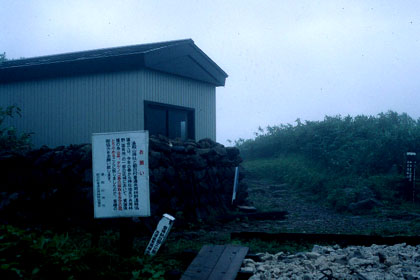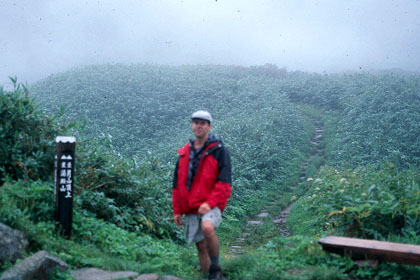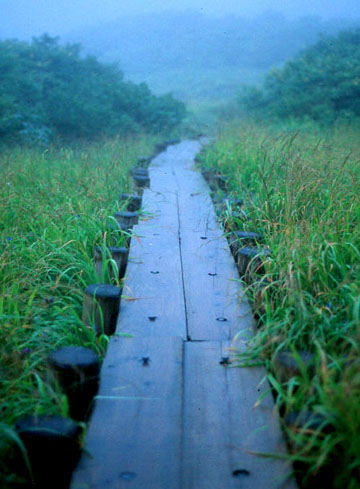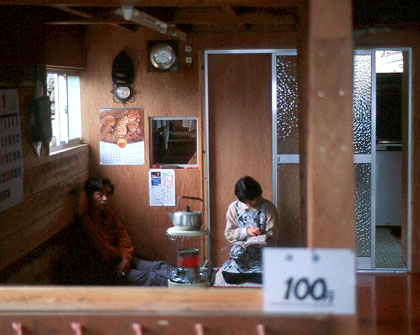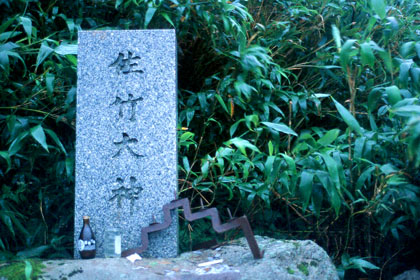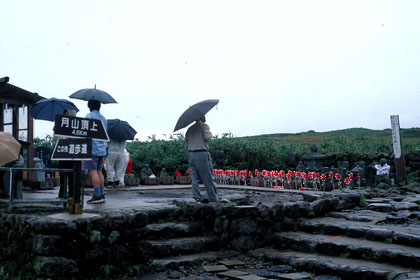|
Yokohama, August 26, 1998
After arriving in Yokohama via JR (Japan Rail) at 8:00 in the evening, I go straight to Katsumi's office, thence dinner. Iím dog-tired after the long flight, fuzzy-headed and not a little feverish from a cold that just won't go away. Katsumi and I eat Thai food. I note that the streets and shops appear on the outside to be just as classy and robust as during any of my past visits. Economic disaster may be looming for Japan, but it's hard to sense in the shops, restaurants and streets. I do notice that the restaurants are less crowded, and many of the shop windows are plastered with "Sale!" banners. Deep discounts are not a new development here, but seem more apparent now. Katsumi readily agrees to keep one of my bags, and my suit, and my laptop computer at his office while I travel for a few days. I feel apologetic about this: Katsumi works without a break, six or seven days a week to sell my products, and I impose on him with my selfish requests so I can take these leisurely trips through the countryside. I leave his office wondering if this is a prudent way to start the trip. I check into the Yokohama Washington Hotel. Itís a business hotel, with above-average comfort and amenities, a nice front desk and full staff. With the weak yen I pay around $65 for a single room, compact but clean. Still a bit jet-lagged, I go for a long walk across Yokohama, and after midnight ride the elevator to the top of Landmark Tower, slipping past the doorperson into the lounge to see the view. Back in my room, I take a bath and watch American music videos on the small television set until I fall asleep. Heading North Yokohama steams under low clouds and sporadic rain. It is hot, humid (mushiatsui, which directly translates as "bug-hot") and at the same time dark and mildly oppressive. I leave my suit and one bag with Kurashige-san, hoist my pack and find my way via a JR commuter line to Tokyo station, where I board a Shinkansen heading north to Morioka. The bullet train passes through the Fukushima area. It is raining here as well, and the rivers we pass are high, some flooding over their low banks as they wind through farmlands. Most of the rivers we pass are protected with high dikes. But as the train slows and pulls into Koriyama I see neighborhoods -- houses, roads and businesses, that are awash in floodwaters. This is typhoon season, and Tohoku -- northern Honshu -- has been hit hard. Flood control has been used as one of the justifications for Japanís massive, wasteful and environmentally devastating public works projects. The country has a long and sordid history of cronyism between local politicians and the massive construction companies that operate here. Dams, dikes and seawalls weigh down the land. One has to suspect that Japan holds more metric tons of concrete per square kilometer than any other nation. And to the politicians and construction firms this must make perfect sense. After all, the raw materials needed for concrete (cement, sand and gravel) are among the few natural resources found in abundance here. At Morioka I transfer to the new Akita Shinkansen, which travels over the spiny central mountains to Japanís west coast. The train makes a brief stop at the mountain town of Tazawa-ko, which is where I disembark. My hastily determined plan is to take a two-day hike along a ridge, including a trip over the summit of Mount Iwate-san. In stammering, first-year Japanese I talk with a woman at the JR information counter. She seems to be telling me that the trails around Iwate-san are closed. I at first think it is because of the Typhoon winds that have been blowing in recent days ("kaze desu"), but after the woman does an entertaining pantomime I realize she is telling me that there is volcanic activity ("kazan desu"). But Iíve come this far, so I walk across the street to the bus station and buy a ticket into the hills, to the end of the road. The bus does not depart for another 45 minutes so I walk through town looking for a food store. I find a small shop selling fruit and buy two apples. I ask the old woman behind the counter if she has any bread. She says, just a moment (chotto mate) and bustles into a back room. Through a crack in the curtains I see her dump the contents of a small plastic bag onto the floor mat. She returns with three items -- all sweet pastries with supermarket wrappers, part of a recent shopping trip, I figure. I ask if there is a bread store around here. She thinks, then points down the street in the direction Iíve been heading. Supermarket, she says. I thank her and pay for the apples, leave the pastries and head up the street. On the bus to the Nyuto Onsen area there are a few older people, a few office ladies (OLs, as they are known here) on holiday, and a few local school kids on their way home. It is Thursday. It is also getting late, and Iím getting a bit concerned about finding a place to camp before dark. At the Ganiba Onsen (one of at least six hot spring inns clustered here), two hitchhikers from Sweden tell me that the trails here are steep, slippery and have many roots. They offer that they wouldn't want to be on them after dark. I go into the onsen and ask where the trail to Iwate-san begins. No one seems to know, but my map shows it near another onsen a short walk down the road. I find the trail easily enough and start up. The Swedes were right; the trail is difficult and poorly maintained. It is just four kilometers to where my map shows a camping area, but after about thirty minutes of hiking it begins to get dark, earlier than I had expected. I pass a new-looking sign that I canít quite read, but it seems to be a warning, perhaps related to Iwate-san? Ten minutes later another sign, this one slightly different from the first. The additional kanji I think I can read: it says to go back down. At this point I figure I have -- at the most -- 30 minutes of daylight left. I press on until I find a wide, flat spot on the trail, then stop and set my tent. As the light goes, I enjoy the view of a mist filled valley, eat rice balls and dried squid, and wonder if the winds will pick up or die off during the night. Ganiba Onsen The weather does not improve; there is rain and strong wind most of the night, but the tent is comfortable. The sky lightens at 4:30, and Iím up at 5:00. Itís still raining lightly. Breakfast is a handful of dried fruit and an apple, and one granola bar. I arrange the pack, pull on my damp clothes (cotton is death, wrote Joe Kane), put on a rain jacket and crawl outside. The valley is filled with mist, and it is still raining. I decide that Iwate-san will not welcome me today. I quickly take down the tent and head down the now well-lubricated trail. The underbrush is dripping and soon my pants are glistening with water and heavy on my legs. It occurs to me that I will have no way to dry them, and I give myself some verbal abuse for having forgotten rain pants. When Iím near the trial's junction with the road, I stop to remove the wet jeans and put on more sensible shorts. It is now 7:00. I spend a few minutes inside a bus shelter rearranging the pack. There is a large puddle next to the shelter and I try rinsing the mud off my shoes with only partial success. But with clean wool socks and a fresh shirt I figure I'm ready to hit the onsen. It is quiet at Ganiba Onsen. A few people wearing yukata (cotton kimono) wander through the lobby, apparently on their way to breakfast. I spot a young woman carrying a load of towels and ask her what time the onsen will open. Now is OK, she seems to say. I go back outside and rummage through the pack for a towel and my shaving kit. Thus equipped, I go back inside. This time, however, there is an older woman at the front desk who looks rather stern and officious. She taps her wrist and says, eight o-clock, then turns her back to me and starts rearranging odd bits of clutter that are scattered around the room. I buy an orange juice from a vending machine, find a chair and sit down to wait. How can I describe this place? It is a two-story stucco building, painted a chipped yellow with a red metal roof. The front entry is framed with large wooden tree trunks, still wrapped in their bark. Between the parking area and the building there is one scruffy maple tree, a large hydrangea bush and some smaller perennials that are long past flowering. Behind this small garden, a sliding wood and glass screen opens into an outer foyer. There are wooden ski racks here, now empty. Another set of inner door leads into the genkan, or formal entryway. The shoes of the Innís guests are arranged neatly on the tile floor, no doubt having been carefully arranged the night before by the fussy desk clerk. A low wooden step leads up to the lobby, which is floored with a green expanse of plastic indoor-outdoor carpeting. To the right of the entry and lobby there is an old wooden telephone booth and the registration counter. To the left there is a rack of brown vinyl slippers. Also to the left, and to the rear, are hallways leading, presumably, to the guest rooms, the dining room and the baths. Here in the lobby, a battered pair of upholstered chairs face off against an equally battered low couch. There is a table between, and a dented copper tray filled with ashy refuse. The smell of the room is of old cigarette burns, pine wood, yesterday's tempura, and just a trace of sulfur. A small dog yaps lightly whenever I pass in front of the counter, but is otherwise immobile. At the registration counter there are souvenirs for sale: phone cards and lighters with Ganiba Onsen printed on them; key chains and pencils with printed cartoon characters; handkerchiefs; sweet rice cakes... The weather outside is improving, but only slightly. I go out and sit on the front steps. Soon a man comes out with a bag and an umbrella. He looks at the sky, then says in good English: nice morning. I say back to him, in poor Japanese, yes, very nice weather. We laugh. Typhoon, he says, then walks through the rain to his car. The outside bath, or rotenburo, is built of large boulders set in concrete surrounding a concrete-floored pool. It is vaguely, perhaps intentionally, shaped like the island of Honshu. The pool is about 20 meters from one end to the other. There is a wall of vertical logs forming a visual barrier of sorts from the path. A shed-like building, also built of poles and timbers -- forms a primitive dressing area. The peaked roof of the shed extends over the water or the pool, creating a protected area out of the rain. This is a mixed bath, with no physical segregation between male and female bathers. But at the moment I am its only occupant. I sit on a rock with my small towel and enjoy the sound of the stream that runs next to the hot pool. There are two eggs submerged in the hot stream of sulfurous water that feeds the pool. After a time a man with an umbrella walk down the path toward the pool. He stops at the stream and gingerly lifts the two eggs from the water, quickly wrapping them in a brown cloth. I ask him, breakfast? Lunch, he replies. After a time I decide to try the inside baths. I get out of the water, slip on the yukata and stumble up the path in the too-small slippers that have been provided. The inside baths are segregated by sex. I open a door marked with the kanji (Chinese character) for "man" and step inside, trading the outside slippers for a fresh set of inside slippers. As if in answer to my prayers, there is a coin operated washing machine and dryer just inside the door here. I happily change slippers again and return to the front entry to retrieve my bag of damp and soiled clothes. Into the wash go the jeans and two-days worth of dirty laundry. There is no detergent in sight, so I improvise with a squirt of toothpaste. The washer chugs along while I soak in the large cedar tub in the next room. There is a large window on one side of the room, facing the woods. The bath is dark; its four small fluorescent fixtures canít compete against the moisture-darkened cedar planks that form the walls, ceiling and floor. I'm joined by a thin, talkative man who I saw earlier arriving with his wife. He asks where I'm from, what is my job... he talks of his trip to New York, he asks about Seattle. He asks if Americans go to onsen. I tell him it is rare, that most Americans have never tried onsen. He expresses surprise, onsen is good, isnít it? The clothes tumble in the tired old dryer. The rain has stopped, so I unpack the tent and hold it up in the breeze, first the rain fly then the lower part. The sun comes out for a few moments and the nylon dries quickly. I add more coins to the dryer and wonder idly if it really produces any heat. It is the time of day when yesterday's guests have left, but too early for the new guests to have arrived. A vacuum cleaner is wheezing it's way across the green carpet. A bent old woman pushes a mop through the halls. A man arrives on a 50cc Suzuki, a large bag of vegetables strapped across his back. A delivery truck comes and goes. The clothes are still in the dryer, so I take a walk down the hill. I meet a man with a camera walking up the hill, and we stop and chat. His name is Masayuki Sunagi. He tells me he works at a bank in Akasaka (a district of Toyko). I propose, perhaps rudely, that working at a bank in Japan might be a little bit dangerous -- the economy is in bad shape. He laughs and says yes, but the pay is good, 10,000,000 yen per year. I excuse myself after a time to go back and check on my clothes. They seem, after 40 minutes of tumbling, to be just as damp as when I put them in. But I feed more coins to the machine anyway. Returning to the front of the inn, I see Sunagi-san filling out a registration form. He offers to buy me a beer, and I accept. It seems as though my clothes will be tumbling for quite some time, so I suggest the rotenburo. We soak in the bath, this time in the company of a half-dozen or so others. Bathers come and go... an older woman from Nagoya with missing teeth and many questions, two younger couples, a man from Sendai who suggests I go south to avoid the storm... Finally, after two more offered beers, the clothes are dry. It is pouring down rain again. Someone tells me that it is the remains of a typhoon that hit Guam before landing north of Tokyo the previous night. Thirty people dead, Iím told. Slightly drunk, I re-pack my clothes and walk under my umbrella to meet the 2:29 bus back to Tazawa-ko. I decide to take the advice of the man from Sendai and go south. Akita I take a local train from Tazawa-ko to Akita via Omagari. The train passes through the most beautiful, dense and verdant forest I've seen anywhere in Japan. The rain only adds to the sense of green here. Steep, tree-covered hills rise from flat valley floors. The fields here are so flat it is as if the farmlands were poured into the valleys as liquid, then allowed to settle into lakes of greenery. And in geological terms perhaps this is exactly what has happened; these are very old river valleys between steep and eroded hills, the products of eons of river meanderings, yearly torrents of rain and the resultant mudslides that have filled the valley floors with rich, fertile soil. In many respects the geology of this place reminds me of the upper Skagit valley, north of Seattle, where steep eroded and forested slopes also end abruptly in a flat valley floor. The train makes a long stop at Kakunodate, where it quickly fills with high-school aged boys and girls in school uniforms. The girls wear white and blue plaid skirts with modest sailor-style blouses. The boys wear dark blue pants and simple white shirts with short sleeves. Out of school now, the boys pull the tails of their shirts out of their pants and jostle around the train car, never sitting still. They carry a diverse collection of scuffed backpacks and courier-style shoulder bags. To a one, the girls carry identical blue and brown book bags. Akita -- another medium-size Japanese city, virtually indistinguishable from Morioka, Kagoshima, Sendai... It continues to rain. After pondering the train schedules I make the decision to stay here for the night rather than continuing south this late in the day. The Akita Mediterranean hotel is one of the better hotels near the station. Itís not cheap, but at $70 for the night itís not terribly expensive either. After checking in (and letting a bellboy carry my backpack up the elevator), I go out for hot soba and tempura, then a quick walk around downtown. Iím in bed by 10:30. Dewa Sanzen In the Akita station at 7:30AM, I arrange a ticket south to Tsuruoka, which is near a cluster of small peaks laced with hiking trails, according to a hiking book Iíve brought from the states. The train does not leave for another hour, so I find a small cafť in the station and have a coffee, juice and a pastry. Between 7:30 and 8:30 the station is mobbed with students, boy-men and girl-women in their high school uniforms. If these uniforms are an attempt by the government and school administrators to perpetuate a cultural conformity, then it appears to be a fruitless attempt. Look closely at a group of high-school age Japanese and you can see the individual choices that define each studentís self-image. Start with the shoes: where one girl wears conservative low black pumps, another has made a direct challenge to authority by wearing hipster-style ankle-high boots with three inch thick soles and bulbous toes. Other girls accentuate their legs by wearing baggy white leggings that slump down over the tops of their shoes and accordion in loose folds halfway up their shins. The effect is more than mildly suggestive, looking rather like a pair of tights that have been pulled down to the ankles. Often combined with this subtle fashion statement is the somewhat more explicit practice among older girls of wearing a regulation skirt that is two or three sizes too small, and that therefore rides a good four inches too high on the waist and correspondingly higher at the thigh... But although certain powers within the government and among the school administration may attempt to squelch such behavior, the Japanese culture (like every other first-world culture) does everything in its mindless power to promote the early sexualization of its women. Magazines for young women here are filled with the same image-focused ads and articles ("Bust Up Cream!"), the same pouting supermodels, the same implicit valuation based on potential for sexual arousal as found in any copy of 17 Magazine or Cosmopolitan. My train arrives and, regrettably, Iím forced to leave the throngs of future housewifes and salarymen (and supermodels and gansters?) and get on board. The train from Akita to Tsuruoka, the Hokuto Limited Express, travels along the Japan Sea coast for much of its route. This is a very pretty section of coastline, sparsely inhabited and rugged. The water does not have the angry churning that I remember from the eastern coastline, but the outcroppings of rock and high cliffs give the coast a natural drama missing from most of the Japanese coast. But here, as in most other coastal areas, there are frequent and extensive stretches of concrete tetrapods and sea walls. Here, as everywhere, the construction companies have shaped the coastlines to meet the needs of their shareholders. Twenty minutes south of Akita we pass through a green forested valley framed with low hills. There is a large temple set on a hillside among mature cedars. The feeling here is of spaciousness, and the green of a well-watered landscape. It is still raining, but with less intensity. The clouds are low, but bright, suggesting they may soon clear. A shrine flashes by the window: an ancient toori, and a slab of rock stands vertical in a bamboo garden. At Honjo, far from anywhere it seems, there is a massive construction project located at the base of the foothills, overlooking planted fields. I see three enormous construction cranes, and towering walls of scaffolding. A factory? This seems an odd place to site such a huge facility. There are no high-speed trains, no major airport, and the winters here are terrible. The site quickly disappears as we move south. After arriving mid-morning in Tsuruoaka I stop at the Japan Rail information office. Iím disappointed to find that it is raining here also. A helpful woman in the office calls a mountain lodge near Haguro-san and the north trail to Gassan. Haguro-san, Gassan and Yudono-san are three small peaks in the north-central Japanese mountain range that is often called the "Japan Alps". The staff at the mountain lodge claimed to have good weather (and a room, would I like a reservation?). But the bus to Haguro-san doesn't leave for more than two hours. I decide to take an earlier bus and approach Gassan from the south, at the Yudono-san shrine -- a longer hike but, in theory, a quicker bus ride. I find the bus to Yudono-san, but after an hour-long ride I find that it is the wrong bus. The bus goes to the Yudono-san hotel, not to the large shrine at the end of the road. It is still raining. No one at the hotel seems to know how to travel the remaining four kilometers (or is it six?) up to the shrine without a car. So I start walking, hoping to catch a lift. There are very few cars. A few hundred meters up the road I find a well-used trail on the uphill side of the road. I take it on a hunch, and sure enough it leads straight up the hill, cutting across the switchbacks in the road. In 45 minutes of pleasant hiking through the forest I reach the shrine at Yudono-san Jinja. There is a small store at the shrine, and I stop for some green tea ice cream. I call home from a payphone, then watch two buses carrying camera-toting tourists. The tourists soon fill the gift shop, picking through the cheap straw hats, wooden staffs and other souvenirs that are for sale here. As it happens Iíve arrived in the middle of an important event: the Dewa Sanzen pilgrimage. The pilgrimage, I read in one of my books, is a yearly event centered around the three sacred peaks of Yudono-san, Haguro-san and Gassan. Members of the ancient Shugendo sect of the Shinto religion, led by colorfully-dressed priests called yamabushi, make pigrimages to the summits of all three peaks during this end-of-summer event. Observing the visitors to the shrine I quickly see that, as in most religions events, there are two kinds of participants. The most numerous of the pilgrims arrive by the busload, scamper through the rain to be photographed under the enormous red toori (one of the largest in Japan), then take refuge in the gift shop until it is time to leave, presumably for the next shrine on their rolling tour. The remaining pilgrims, most of them older, make their way up the trail dressed in white garments and straw hats, seemingly oblivious to the weather. These pilgrims have intense, thoughtful expressions. They move more slowly, without the bird-like hyperactivity of the bus tourists, and maintain eye contact as they quietly smile at me. It is a walk of about two kilometers from the shrine up to a small clearing next to a river. There I find very old, crumbling rock walls and a bubbling, oozing cliff of hot mud streaked with sulfur. There is a shelter with benches where pilgrims wait and rest. A priest burns characters into their staffs with an iron brand lifted from a fire. I continue upward; this is not my pilgrimage and I feel somewhat out of place -- and clumsy -- among the pilgrims and priests. The trail toward Gassan is steep, cut from rocks which form hundreds of steps between the bamboo grass underbrush. At times it is so steep that long iron ladders have been installed on the cliffs. The climb is long, wet and exhausting. The cold wind invades my clothes when I stop to rest, so I keep moving. After an hour or more of relentless climbing the trail levels out on a ridge top. A small white building with aluminum siding appears through the mist. I try the door: it opens into a single spacious, cedar lined room. There is well-crafted raised platform for sleeping, a sink with cold running water, hooks for hanging clothes. This is a mountain hut, not shown in my hiking guide. I decide to stop for the night.
Gassan The din of the rain on the roof is loud -- almost deafening at times -- but in the morning there is only fog with no rain. As I look out the window from my sleeping bag I see two ptarmigans emerge nervously from the underbrush. They startle at something and fly away. I pack and get an early start, on the trail at 5:00. At the junction of the trails to the Yudono-san and Gassan summits there are more stone steps leading up respective ridges. The mist returns, rising from the valley on a gust of cool wind. Every few paces there are small piles of rocks, coins, bits of knotted twine. There is a signpost indicating only .9 KM to Gassan summit. Now it begins to rain, hard. I have a small travel umbrella but the rain is coming from everywhere and nowhere and soon I'm drenched. Itís a hard scramble up the slippery rock steps. Occasionally the mist clears and I see a building near the summit. It looks very close, but in fact the building is quite large so appears closer when viewed through the fog. Finally I reach it, soaked. There is an entrance, but it is locked. No shelter, not even an overhanging roof. I see movement through a window. Soon a middle-aged woman, rubbing sleep from her eyes, unlocks and slides open the door. She waves me inside. It is warm inside. A black and white cat mews at me. A large concrete-floored entrance area (the genkan) has hooks where I hang my wet clothes. I change to a dry shirt and fresh socks, then step up onto the tatami mats and polished hardwood floor of the front room. From the small kitchen area comes music -- a pop station is playing a familiar American folk-rock tune. The woman appears again and asks if I want breakfast. I ask hopefully if she has miso soup. She says yes, and soon a steaming bowl is placed before me. She offers tea and coffee, and more miso soup. She compliments me on my Japanese, but she is a being polite. More tea, more coffee. Through a small opening in the kitchen wall I see a man -- her husband, I guess -- climb down a steep set of stairs. He pulls a pair of pants over his long underwear, then comes out and sits on the floor. He lights a cigarette and stares at the ceiling while he smokes it. After a time he goes outside, then returns with a large plastic jug of kerosene. He fills a space heater and lights it. I ask him if it was cold here last night. He doesn't understand my Japanese and I try again, more carefully this time. He says no, not cold, but it rained a lot. The man lights another cigarette, then goes outside. The cat mews again and wanders close for a scratch. The woman feeds him a few sheets of dried seaweed. I stay for nearly two hours enjoying the warmth, reluctant to venture back out in the rain. Finally I get up and stretch, and don my still-wet sweater and rain jacket. As I'm packing to go the man says something and points out a window. I look; there is an expansive view down the ridge where I had trudged two hours earlier. The mist blows like silk curtains, and we watch a group of pilgrims climbing toward us. I pay for my refreshments and exit. For my tea, coffee and soup I pay a whopping twelve dollars, but I console myself with the knowledge that everything here was either packed in or delivered by helicopter. Considering the winds up here, I decide that a helicopter visit might be a rare thing. At the nearby summit Iím confused by a web-work of trails and unreadable signposts. I walk into the shrine that caps the summit. When I enter under a stone arch I surprise an old priest who is sitting in front of an iron charcoal burner. He lets out a small gasp and almost drops the staff he is carefully branding. I apologize profusely and ask him where the trail to the ninth stage is, pointing at the place-name printed in my trail guide. He leads me to a path that circles around the shrine and points the way. I thank him and go. Between the eighth and ninth stages I step aside as a large group of pilgrims pass on their way up. In the midst of the pack is one lone European, looking a bit bemused as he walks past. He says "Hello" with a German accent and continues on his way. He is wearing the straw hat, baggy white clothes and sandals of a pilgrim. He is tall; I wonder where he found such large footwear. With bells on their feet, most of the younger pilgrims wear hiking boots or Nike sneakers, and wear stylish rain gear over their robes. The older men and women, with sun-weathered faces and strong, muscle-corded hands, wear thin cotton and straw split-toed sandles and have little protection from the rain. They will take three summits on their pilgrimage; Iím impressed. I note with interest that many of the men have shaved their heads, and a few of the women have as well. At the eighth stage, a short hike from the parking lot and bus stop, another group of pilgrims is preparing to leave. A yamabushi priest wears a sky blue long gown, a white cloak with yellow trimming and a peaked hat. He carries a short, flat paddle. He enters a small shrine; a low-toned bell rings out, repeating with greater frequency, then stops. The pilgrims leave, bowing to two women in white who stand in front of the small building near the shrine. The two women walk over to the bench where I have stopped to sit and rest. They suggest that I come in for tea. I sit inside, sipping tea, and listen to the chanting of the priest outside. At intervals there are the sounds of small chimes or cymbals. The wind blows through the bamboo grass, the women quietly bang pots as they clean in the kitchen. Pilgrims come and go... somewhere deep inside the building there is a television, its voice echoing through the tatami halls. Much later, in the evening, I am drinking beer with Kurashige-san in a dark Yokohamo bar. He says, "In this weather only the crazy Yamabushi, the pilgrims, and you will do such kind of thing..." - September, 1998
|
